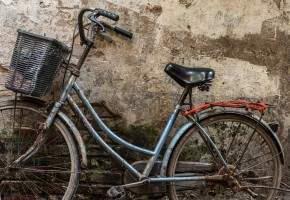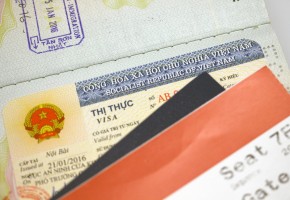
Safety, scams & traveling solo
Overview
Overall, Vietnam is an amazingly safe country for travelers, including women and solo travelers. There is almost no violent crime that affects tourists, and you can walk safely around the major cities at virtually any time of the day; the country towns too.
Vietnamese people are friendly and hospitable, and wherever you go people are welcoming and ready to help if you need it. In our experience, it’s one of the safest countries in Asia for travelers.
Of course there are the usual low level scams (see below) targeting unwary visitors; apart from scams, it is (mostly self-inflicted) ‘incidents’, petty theft or carelessness, that seem to cause visitors trouble.
We see a lot of travelers being careless with valuables or wallets; wearing inadequate clothing while riding a rented motorcycle; trekking in slippery conditions with poor footwear; not protecting themselves against sunburn; and crossing streets without understanding how to do it in Vietnamese traffic, to name but a few.
Domestic flights are inexpensive and connect to many smaller towns. Hiring a comfortable private car with good driver is affordable and a great way to travel. Riding a motorbike has been made easier by better roads & improved acceptance of foreign licenses, which makes insurance coverage less problematic.
Even the taxis and xe-oms (motorbike taxis) in the cities are easy to use.
However, understanding the transport picture in at least reasonable detail, plus some pre-planning, will make a big difference in the comfort and success of your trip.

Getting to and from Vietnam
Most travelers arrive in Vietnam by air, but the country also boasts numerous land crossings with all its neighbors, and it is also possible to enter Vietnam by boat from Cambodia and by train from China.
Vietnam has two key international airports, Tan Son Nhat Airport in Ho Chi Minh City and Noi Bai Airport in Hanoi.
After major renovations in recent years both have modern, large, clean terminals which function well — mostly.
However they can also be very congested with long queues at peak times (and especially around the new year festival of Tet, in late January or early February), so travelers need to allow generous time to get through the airport, both arriving and departing.
You might get lucky and get through quickly, or it might take an hour or two.

Da Nang, which accepts a far smaller but growing number of international flights, is home to a third international airport, and can make sense as an entry point if you particularly want to start by visiting Hoi An or Hue, but coming via Ho Chi Minh is probably as easy and likely cheaper.
Phu Quoc, an island in the south of Vietnam, also has an international airport, but is focused mainly on tourists who want to holiday on the island.
While there are a growing number of direct long-haul flights to Ho Chi Minh and Hanoi from places like Europe and America, many international carriers still route via the Asian hubs of Bangkok and Singapore.
It can be cost effective to purchase a long-haul ticket to one of these hubs and then get to Vietnam using one of the budget regional airlines — but travelers need to be aware that delays and cancelled flights into Vietnam, especially with the lower cost carriers, can and do happen and this can create havoc with tightly scheduled itineraries.
It is a question of chance of course, but if you have a tightly planned schedule, and cannot afford to lose a day here or there, then we think it is best to fly direct to Vietnam and avoid budget connections.
For more information on airports, airlines and connections, including information on taxis and airport transfers, see here.
A little research on the Internet will help you get a feel for the relative merits, on-time record, on board services etc of various airlines. Skytrax is one source, but like any source it should be treated with some skepticism.
If you book at least 3 months ahead, you can generally find good prices from reputable airlines for travel to and within Vietnam.
Getting around within Vietnam
Travel within Vietnam can be quite easy if you do some planning, and frustrating if you don’t.
In our experience, as outlined here, a smart way to cover longer distances is to use domestic flights to regional centers, and explore from there — you can spend less time on the major roads and more time on the back roads, which is where a lot of the real Vietnam is.
Trains are also good for long distances, and can convey a wonderful sense of old Vietnam as they wind through timeless landscapes. But trains are more limited in the coverage of places you can travel to, and the rail infrastructure is ageing: trains are slow and noisy, rattling along the tracks.
Intercity express buses can be excellent for middle to longer distances. They are typically modern, air-conditioned and comfortable, they cover all major regional centers and they are inexpensive.
Limousine buses, with fewer, even more comfortable, reclining seats, are a slightly more expensive Vietnamese specialty and a great hassle-free way to travel longer distances in comfort.
Overnight sleeper buses are yet another option, although we found that the seats tend to be a little shorter and more narrow then the Limousine buses, so a fully reclined position still leaves an average taller foreign traveler not quite comfortable enough.
If you are traveling by motorbike, you can generally pay extra to put the bike in the luggage hold under the bus, get some rest on the bus, and arrive at your destination ready to ride.
Local mini buses run between the regional centers and the smaller towns around them. They are often crowded with local people doing their day to day shopping. They are mostly not air-conditioned, and they are slow because they stop often; connections between different mini buses can be poor, and they are often seem to be driven by madmen.
However, for authenticity and local flavor they are the real deal. We have met many people who travel this way, though mostly they were pretty relaxed about how long it took to get to where they were going.
See here for more information on trains and buses.

Traveling by private car & driver is a fabulous and surprisingly affordable way to experience Vietnam.
With a car, you travel faster than by motorbike, which gives you more opportunity for interesting side excursions, treks to local villages, photography stops, or whatever else takes your interest.
Many travel companies can arrange a modern, comfortable car or SUV or van or minibus, plus a driver — but choosing a reputable company which will guarantee the quality of the car and the driver’s experience is essential. Other Path Travel’s long-term relationships with reliable car companies will of course ensure that your trip with us will be safe and enjoyable.
As most drivers do not speak much English, generally you will want to hire an English speaking guide as well.
If he/she is good, the guide will add hugely to the enjoyment of your trip not just by taking care of things like hotels and restaurants, but also by helping you have a richer and deeper experience of the region and its people.
If you are OK with riding a motorbike, there is no better way to experience traveling through Vietnam. The connection with the country and the people is fantastic.
Vietnam is perhaps the best country in Asia to ride a motorbike — the scenery is wonderful, the roads are good enough, and the whole country (off the highways) has a motorbike culture.
Motorbikes are still far more common than cars so drivers are (mostly) very conscious of motorbikes and take care, and average road speeds are relatively low, especially for back roads, partly because the motorbikes that most people use are small and partly because the roads themselves are often twisting and don’t support going very fast.
It all makes for a perfect mix for motorbike riding. See here for more information on travel by motorbike.
Safety, scams & traveling solo
Overall, Vietnam is an amazingly safe country for travelers, including women and solo travelers. There is almost no violent crime that affects tourists, and you can walk safely around the major cities at virtually any time of the day; the country towns too. Vietnamese people are friendly and hospitable, and wherever you go people are welcoming and ready to help if you need it. In our experience, it’s one of the safest countries in Asia for travelers.
Of course there are the usual low level scams (see below) targeting unwary visitors; apart from scams, it is (mostly self-inflicted) ‘incidents’, petty theft or carelessness, that seem to cause visitors trouble. We see a lot of travelers being careless with valuables or wallets; wearing inadequate clothing while riding a rented motorcycle; trekking in slippery conditions with poor footwear; not protecting themselves against sunburn; and crossing streets without understanding how to do it in Vietnamese traffic, to name but a few.







